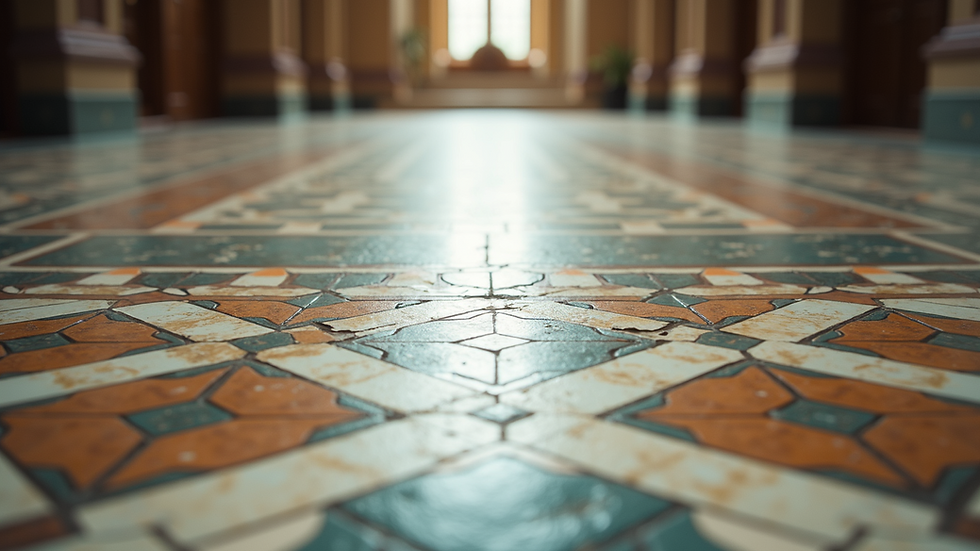Exploring the Timeless Appeal and Versatility of Tile Flooring Options
- TJ Talbot
- Aug 11
- 4 min read
Updated: Aug 17
Tile flooring has captivated homeowners and interior designers for centuries, thanks to its blend of aesthetic beauty, practicality, and durability. Whether you're looking to refresh your home or embark on a new build, understanding the various tile flooring options available can help you make the best choice for your space.
Tile flooring comes in various materials, designs, and textures, making it an incredibly versatile option for any room in your home. This blog post will explore the types of tile flooring, their attributes, and how they can elevate your living spaces.
Types of Tile Flooring
Tile flooring primarily falls into four categories: ceramic, porcelain, stone, and glass. Each type carries distinct features that cater to different needs and preferences.
Ceramic Tile
Ceramic tiles are made from clay and other natural materials, fired at high temperatures. This process gives them strength and durability, making them ideal for various applications.
Ceramic tiles come in a myriad of colors, patterns, and sizes, allowing for endless design possibilities. They are often used in kitchens and bathrooms due to their water resistance and ease of maintenance. The only major consideration is that they can be susceptible to chipping or cracking when heavy objects are dropped on them.
Porcelain Tile
Porcelain tiles are a subtype of ceramic, known for their density and low water absorption rate. They are made from finely ground sand and clay, fired at even higher temperatures than standard ceramic tiles. The resulting product is incredibly durable and much more resistant to scratching and staining.
This makes porcelain an excellent choice for high-traffic areas and outdoor spaces. Additionally, porcelain tiles can mimic the look of natural stone, wood, or even fabric, offering endless design options for homeowners.
Stone Tile
Natural stone tiles, including granite, marble, slate, and travertine, offer a unique and timeless look. Each stone tile has its own pattern and color variations, making every installation distinct.
While stone tile exudes sophistication, they require more maintenance compared to ceramic or porcelain, as they can stain or etch if not properly sealed. However, their durability and natural beauty make them a sought-after choice for luxurious kitchens or elegant entryways.
Glass Tile
Glass tiles are often regarded as the most visually striking option for flooring. They reflect light beautifully, adding a luminous quality to spaces. These tiles are usually used in combination with other materials, as they are more commonly found in backsplashes, mosaics, and accent features in flooring.
Though glass tiles can be pricier than other options, their striking appearance enhances any room’s aesthetic instantly. However, potential buyers should note that they may be more susceptible to scratches compared to ceramic or porcelain tiles.
Benefits of Tile Flooring
Tile flooring is more than just aesthetically pleasing; it also brings a multitude of practical benefits.
Durability
One of the main selling points of tile flooring is its extraordinary durability. Most types of tile are resistant to wear, scratches, and stains. This means that tile flooring can maintain its appearance even in the busiest households.
Low Maintenance
Compared to other flooring options like carpeting or hardwood, tile flooring is remarkably low maintenance. Regular sweeping or vacuuming and occasional mopping are usually all that is necessary to keep tile floors looking fresh.
Versatility in Design
Tile flooring offers unrivaled design flexibility. Homeowners can choose from various sizes, shapes, colors, and finishes, allowing for personalized looks that suit any decor style, whether modern, traditional, or somewhere in between.
Eco-friendliness
Many tile flooring options are made from natural materials and can be recycled at the end of their lifecycle. Additionally, tiles can help regulate temperature, which may reduce energy costs for heating and cooling.
Installation Considerations
While tile flooring offers an array of benefits, installation does require certain considerations.
Subfloor Preparation
A strong, stable subfloor is crucial to ensure that tile remains intact over time. Any imperfections in the subfloor can lead to cracking and unevenness in the finished surface.
Grouting and Sealing
The choice of grout is essential for both aesthetic appeal and functionality. High-quality grout will reduce the risk of staining and moisture penetration. Additionally, natural stone tiles often need a sealing treatment to prevent absorbing liquids.
Professional vs. DIY Installation
While some homeowners feel confident installing tile flooring themselves, hiring a professional can ensure a smoother, more efficient installation. It’s especially advisable for larger projects or intricate designs that require precision.
Cost Considerations
The cost of tile flooring can vary widely, from budget-friendly ceramic tiles to luxurious marble options. It's essential to factor in the expense of both materials and installation, as some types require more specialized labor.
Budgeting Tips
Set a Budget: Before exploring options, determine how much you’re willing to spend.
Explore Various Materials: You don’t need to choose the priciest option for an appealing look; sometimes, a well-chosen ceramic or porcelain tile can create just as stunning a result.
Plan for Additional Costs: Don’t forget to account for underlayment, adhesive, and tools if you’re opting for a DIY installation.
Conclusion
Tile flooring remains a popular choice for homeowners due to its durability, aesthetic appeal, and versatility. By understanding the various types of tiles available and their specific benefits, you can make informed decisions that elevate your living spaces.
Whether you're renovating an existing home or building a new one, tile flooring can meet both your practical and aesthetic needs. You can integrate style and resilience into your interiors with careful planning and consideration, ensuring that your tile flooring will continue to look beautiful for years to come.

Comments